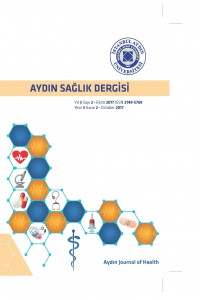Research Article
Year 2017,
Volume: 3 Issue: 2, 51 - 59, 12.10.2017
Abstract
Kraniyofasiyal cerrahide anestezi yönetimi; operasyon süresinin
uzunluğu, aşırı kan kaybı ve masif transfüzyon, zor havayolu
problemleri, intrakraniyal basınç artışı, artmış postoperatif respiratuar
komplikasyon riskleri nedeni ile multidisipliner yaklaşım gerektirir.
Çalışmamızda altı kraniosinositoz olgusu retrospektif olarak
değerlendirilmiştir.
References
- [1] Stricker PA, Lin EE, Fiadjoe JE, Sussman EM, Pruitt EY, Zhao H, Jobes DR. Evaluation of central venous pressure monitoring in children undergoing craniofacial reconstruction surgery.Anesth Analg. 2013 Feb;116(2):411-9 2] Rath GP, Dash HH. Anaesthesia for neurosurgical procedures in paediatric patients. Ind J Anaesth 2012;56:502-12. [3] Barnett S, Moloney C, Bingham R. Perioperative complications in children with Apert syndrome: a review of 509 anesthetics. Paediatr Anaesth. 2011;21:72–7 [4] Chen YL, Wu KH. Airway management of patients with craniofacial abnormalities: 10-year experience at a teaching hospital in Taiwan. J Chin Med Assos 2009;72:468–70. [5] Kozanhan B, Saltalı A . Major özelliği yüz – ekstremite defektleri olan sendromlar ve anestezi yönetimi. Genel Tıp Derg 2016;26(1):28-33 [6] Faberowski LW, Black S, Mickle JP. Blood loss and transfusion practice in the perioperative management of craniosynositosis repair. J Neurosurg Anesthesiol 1999;11:167-72. [7] Di Rocco C, Tamburrini G, Pietrini D. Blood sparing in craniosynostosis surgery. Semin Pediatr Neurol. 2004;11:278-87 [8] Tuncbilek G, Vargel I, Erdem A, Mavili ME, Benli K, Erk Y. Blood loss and transfusion rates during repair of craniofacial deformities. J Craniofac Surg 2005;16:59-62. [9] Seruya M, Oh AK, Rogers GF, Boyajian MJ. Myseros JS, Yaun AL et a Controlled systemic hypotension and blood loss during fronto-orbital advancement. J Neurosurg Pediatr.2012;9:491- [10] Thomas K, Hughes C, Johnson D, Das S. Anesthesia for surgery related to craniosynostosis: a review. Part 1 Pediatr Anesth 2012;22:1033–41. [11] Pietrini D, Ciano F, Forte E. Sevoflurane-remifentanil versus isoflurane-remifentanil for the surgical correction of craniosynostosis in infants. Pediatr Anesth. 2005;15:653–62. [12] Szabo EZ, Luginbuehl I, Bissonnette B. Impact of anestheticagents on cerebrovascular physiology in children. PediatrAnesth 2009;19:108-18. [13] Kim P, Tahon T, Fetzer M, Tobias J. Perioperative hypothermiain the pediatric population: A quality improvementProject. Am J Med Qual 2013; 28:400-6. [14] Macario A, Dexter F. What are the most important risk factorsfor a patient’s developing intraoperative hypothermia?Anesth Analg 2002;94:215-20. [15] Goobie SM, Zurakowski D, Proctor MR, Meara JG, MeierPM, Young VJ et al. Predictors of clinically significant postoperative events after open craniosynostosis surgery. Anesthesiology 2015;122:1021-32.
Year 2017,
Volume: 3 Issue: 2, 51 - 59, 12.10.2017
Abstract
References
- [1] Stricker PA, Lin EE, Fiadjoe JE, Sussman EM, Pruitt EY, Zhao H, Jobes DR. Evaluation of central venous pressure monitoring in children undergoing craniofacial reconstruction surgery.Anesth Analg. 2013 Feb;116(2):411-9 2] Rath GP, Dash HH. Anaesthesia for neurosurgical procedures in paediatric patients. Ind J Anaesth 2012;56:502-12. [3] Barnett S, Moloney C, Bingham R. Perioperative complications in children with Apert syndrome: a review of 509 anesthetics. Paediatr Anaesth. 2011;21:72–7 [4] Chen YL, Wu KH. Airway management of patients with craniofacial abnormalities: 10-year experience at a teaching hospital in Taiwan. J Chin Med Assos 2009;72:468–70. [5] Kozanhan B, Saltalı A . Major özelliği yüz – ekstremite defektleri olan sendromlar ve anestezi yönetimi. Genel Tıp Derg 2016;26(1):28-33 [6] Faberowski LW, Black S, Mickle JP. Blood loss and transfusion practice in the perioperative management of craniosynositosis repair. J Neurosurg Anesthesiol 1999;11:167-72. [7] Di Rocco C, Tamburrini G, Pietrini D. Blood sparing in craniosynostosis surgery. Semin Pediatr Neurol. 2004;11:278-87 [8] Tuncbilek G, Vargel I, Erdem A, Mavili ME, Benli K, Erk Y. Blood loss and transfusion rates during repair of craniofacial deformities. J Craniofac Surg 2005;16:59-62. [9] Seruya M, Oh AK, Rogers GF, Boyajian MJ. Myseros JS, Yaun AL et a Controlled systemic hypotension and blood loss during fronto-orbital advancement. J Neurosurg Pediatr.2012;9:491- [10] Thomas K, Hughes C, Johnson D, Das S. Anesthesia for surgery related to craniosynostosis: a review. Part 1 Pediatr Anesth 2012;22:1033–41. [11] Pietrini D, Ciano F, Forte E. Sevoflurane-remifentanil versus isoflurane-remifentanil for the surgical correction of craniosynostosis in infants. Pediatr Anesth. 2005;15:653–62. [12] Szabo EZ, Luginbuehl I, Bissonnette B. Impact of anestheticagents on cerebrovascular physiology in children. PediatrAnesth 2009;19:108-18. [13] Kim P, Tahon T, Fetzer M, Tobias J. Perioperative hypothermiain the pediatric population: A quality improvementProject. Am J Med Qual 2013; 28:400-6. [14] Macario A, Dexter F. What are the most important risk factorsfor a patient’s developing intraoperative hypothermia?Anesth Analg 2002;94:215-20. [15] Goobie SM, Zurakowski D, Proctor MR, Meara JG, MeierPM, Young VJ et al. Predictors of clinically significant postoperative events after open craniosynostosis surgery. Anesthesiology 2015;122:1021-32.
There are 1 citations in total.
Details
| Primary Language | Turkish |
|---|---|
| Journal Section | Articles |
| Authors | |
| Publication Date | October 12, 2017 |
| Submission Date | August 6, 2017 |
| Acceptance Date | September 9, 2017 |
| Published in Issue | Year 2017 Volume: 3 Issue: 2 |
All site content, except where otherwise noted, is licensed under a Creative Common Attribution Licence. (CC-BY-NC 4.0)

